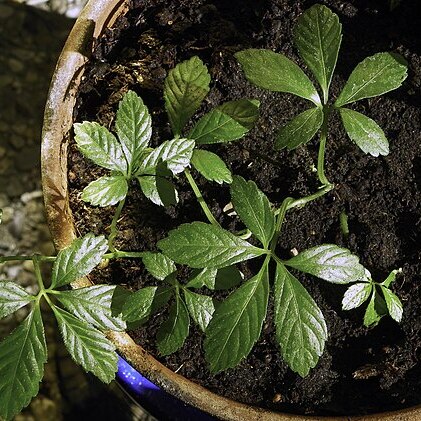Small or medium climbers to 2 m long, main branches subherbaceous or soft woody, leafy stem 1-2 mm diam., glabrous or finely hairy, roots tuberous or not; dioecious or monoecious. Probract absent. Tendrils 2-branched at apex. Leaves: petiole long; leaflets petioluled; blade simple, not lobed or subpedately 3-or 5-(or 7-) foliolate, green on drying, margin dentate, cystoliths not obvious. Flowers (greenish)white, small, rotate; buds globose; sepals 5, free; petals 5, free, imbricate in bud, long-triangular, sometimes ± erose towards apex; disc inconspicuous. Male inflorescences paniculate, 2-4-times branched, few-or many-flowered, the ultimate branches slender with few or several flowers ± clustered in minute short racemes; bracts small, linear, glabrous or finely hairy. Male flowers: pedicel short, articulate, basal part persistent; receptacle narrow, flat or saucer-shaped; petals (long-)triangular or narrowly elliptic, apex acute or (long-)acuminate; filaments united into a staminal column, at apex with 5 (sub)sessile or short-stipitate anthers in a ring, anthers small, 1-thecous, short-ellipsoid, opening with a vertical slit, extrorse. Female inflorescences as in male inflorescences but less ramified and smaller. Female flowers as male flowers but somewhat larger; pedicel short (or long); ovary subglobose, largely inferior, the inferior part not narrowed below the perianth, (2-or) 3-or 5-locular, each locule with 2 hanging ovules; sepals and petals inserted along broad, slightly convex apex of ovary; styles (2 or) 3 or 5, erect, free or ± contiguous, glabrous, each at apex with a 2-branched stigma; staminodes sometimes present. Fruit ripening green, brown or purple, (sub)globose, less than 10 mm diam., with subpersistent perianth and styles (the latter becoming spaced and the perianth-scars leaving a thin line around the fruit), either a dry berry, not dehiscent or ± capsular, opening with 3 valves (not in Malesia). Seeds 1-5, not much compressed, ovoid or subtriangular in outline, faces verrucose or wrinkled, margin narrow or broad, with ± square, grooved edge.
More
Herbs, perennial, scandent, glabrous or pubescent. Leaves alternate, pedate, with 3-9 leaflets, rarely simple; leaflet blade ovate-lanceolate. Tendrils bifurcate, rarely simple. Plants dioecious, rarely monoecious. Flowers unisexual, in racemes or panicles, axillary or terminal; pedicel articulate; bracteole basal. Male flower: calyx tube short, 5-lobed; segments narrowly lanceolate; corolla greenish or white, rotate, deeply 5-lobed; segments lanceolate or ovate-lanceolate, involute in bud; stamens 5, inserted at base of perianth tube; filaments short, connate; anthers erect, ovoid, 2-celled, dehiscence longitudinal; connective narrow, but not extended; pollen grains globose or elliptic, longitudinally striate or smooth, dehiscent by pores; rudimentary pistil absent. Female flowers: calyx and corolla as in male flower; staminodes present; ovary globose, 2-5-locular; styles 3, rarely 2, 4, or 5, free; stigmas 2 or 1 and crescent-shaped and irregularly incised-dentate; ovules 2, pendulous in each locule. Berry globose, in form and size like a pea, or capsule, 3-lobed from top, top umbonulate or with 3 persistent long styles. Seeds 2 or 3, broadly ovate, compressed, with papillae or spiniform papillae.

